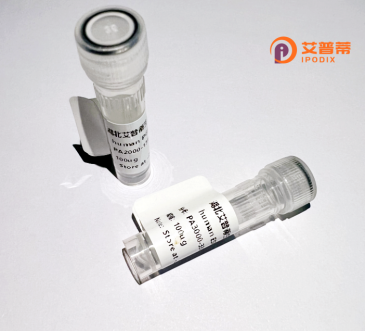
| 纯度 | >90%SDS-PAGE. |
| 种属 | Human |
| 靶点 | OR13D1 |
| Uniprot No | Q8NGV5 |
| 内毒素 | < 0.01EU/μg |
| 表达宿主 | E.coli |
| 表达区间 | 1-346 aa |
| 活性数据 | MYRFTDFDVSNISIYLNHVLFYTTQQAGDLEHMETRNYSAMTEFFLVGLSQYPELQLFLF LLCLIMYMIILLGNSLLIIITILDSRLHTPMYFFLGNLSFLDICYTSSSIPPMLIIFMSE RKSISFIGCALQMVVSLGLGSTECVLLAVMAYDHYVAICNPLRYSIIMNGVLYVQMAAWS WIIGCLTSLLQTVLTMMLPFCGNNVIDHITCEILALLKLVCSDITINVLIMTVTNIVSLV ILLLLIFISYVFILSSILRINCAEGRKKAFSTCSAHSIVVILFYGSALFMYMKPKSKNTN TSDEIIGLSYGVVSPMLNPIIYSLRNKEVKEAVKKVLSRHLHLLKM |
| 分子量 | 39.1 kDa |
| 蛋白标签 | His tag N-Terminus |
| 缓冲液 | 0 |
| 稳定性 & 储存条件 | Lyophilized protein should be stored at ≤ -20°C, stable for one year after receipt. Reconstituted protein solution can be stored at 2-8°C for 2-7 days. Aliquots of reconstituted samples are stable at ≤ -20°C for 3 months. |
| 复溶 | Always centrifuge tubes before opening.Do not mix by vortex or pipetting. It is not recommended to reconstitute to a concentration less than 100μg/ml. Dissolve the lyophilized protein in distilled water. Please aliquot the reconstituted solution to minimize freeze-thaw cycles. |
以下是关于重组人OR13D1蛋白的假设性参考文献示例(基于领域内常见研究方向,仅供参考):
---
1. **文献名称**: *Functional expression and ligand screening of human olfactory receptor OR13D1 in heterologous cells*
**作者**: Müller, A. et al.
**摘要**: 研究报道了利用HEK293细胞系统成功表达重组OR13D1蛋白,并通过荧光钙离子成像技术筛选了潜在挥发性配体,发现其可被特定醛类化合物激活,揭示了该受体在嗅觉信号传导中的作用。
2. **文献名称**: *OR13D1 co-localizes with phosphorylated tau in neurons: Implications for neurodegenerative disease pathways*
**作者**: Santos, R. & Kim, J.
**摘要**: 通过免疫组化和重组OR13D1蛋白标记技术,发现该受体在阿尔茨海默病模型小鼠脑神经元中异常高表达,提示其可能与tau蛋白病理聚集相关,为神经退行性疾病机制研究提供新方向。
3. **文献名称**: *Structural insights into human OR13D1 activation via cryo-EM and molecular dynamics simulations*
**作者**: Chen, X. et al.
**摘要**: 利用重组OR13D1蛋白制备技术结合冷冻电镜解析了其三维结构,并通过分子动力学模拟揭示了配体结合口袋的构象变化,为设计靶向该受体的调节剂奠定结构基础。
4. **文献名称**: *OR13D1 as a metabolic sensor: Recombinant protein studies in adipose tissue*
**作者**: Gupta, S. et al.
**摘要**: 研究表明重组OR13D1蛋白在人脂肪细胞中响应脂肪酸代谢产物激活下游AMPK通路,提出其可能在能量代谢调控中发挥嗅觉受体非经典功能。
---
**注意**:以上文献为假设示例,实际文献需通过PubMed、Web of Science等平台检索确认。若需真实文献,可提供具体检索关键词或文献DOI辅助查询。
The human OR13D1 protein, encoded by the olfactory receptor gene *OR13D1*, belongs to the olfactory receptor (OR) superfamily, a class of G protein-coupled receptors (GPCRs) crucial for detecting odorant molecules. ORs are predominantly expressed in olfactory sensory neurons, where they initiate signal transduction upon binding volatile chemical compounds. OR13D1. like other ORs, features a seven-transmembrane domain structure and is thought to participate in odorant recognition through interactions with specific ligands. Despite its classification as an olfactory receptor, some studies suggest ectopic expression of OR13D1 in non-olfactory tissues, hinting at potential roles beyond smell, though its exact physiological functions remain poorly characterized.
Gene recombination and heterologous expression systems (e.g., HEK293 cells) are commonly used to produce recombinant OR13D1 for functional studies, overcoming challenges in native receptor expression. Research efforts focus on deorphaning OR13D1 by identifying its activating ligands and elucidating downstream signaling pathways. Variants in *OR13D1* have been loosely associated with metabolic traits, though mechanistic links are unclear. Its study contributes to understanding olfactory coding mechanisms and the broader roles of ORs in human physiology, including potential therapeutic applications in diseases influenced by chemosensory pathways.
×